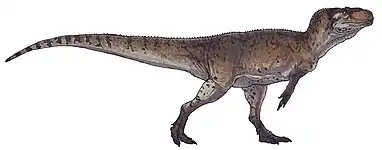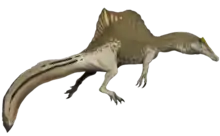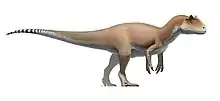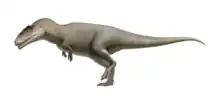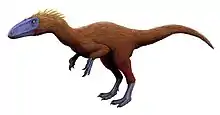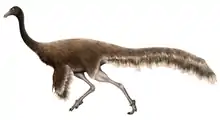Proceratosaurus
Proceratosaurus is a genus of small-sized (~3 metres (9.8 ft) long) carnivorous theropod dinosaur from the Middle Jurassic (Bathonian) of England.[1] Its name refers to how it was originally thought to be an ancestor of Ceratosaurus, due to the similar small crest on its snout.[2] Now, however, it is considered a coelurosaur, specifically one of the earliest known members of the clade Tyrannosauroidea.[3]
| Proceratosaurus | |
|---|---|
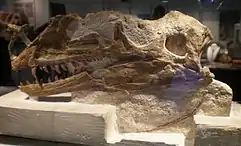 | |
| Holotype skull, Munich | |
| Scientific classification | |
| Kingdom: | Animalia |
| Phylum: | Chordata |
| Clade: | Dinosauria |
| Clade: | Saurischia |
| Clade: | Theropoda |
| Family: | †Proceratosauridae |
| Genus: | †Proceratosaurus von Huene, 1926 |
| Species: | †P. bradleyi |
| Binomial name | |
| †Proceratosaurus bradleyi (Woodward, 1910 [originally Megalosaurus]) | |
| Synonyms | |
| |
The type specimen is held in the Natural History Museum in London and was recovered in 1910 from oolitic limestone of the White Limestone Formation near Minchinhampton while excavating for a reservoir.[4]
Classification
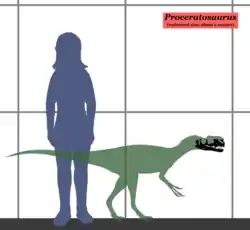
Arthur Smith Woodward, who initially studied Proceratosaurus, originally thought it to be an ancestor of the Late Jurassic Ceratosaurus, due to the similarity of their nasal crests.[5] Later study during the 1930s by Friedrich von Huene supported this interpretation, and Huene thought both dinosaurs represented members of the group Coelurosauria.[6]
It was not until the late 1980s, after Ceratosaurus had been shown to be a much more primitive theropod and not a coelurosaur, that the classification of Proceratosaurus was again re-examined. Gregory S. Paul suggested that it was a close relative of Ornitholestes, again mainly due to the crest on the nose (though the idea that Ornitholestes bore a nasal crest was later disproved). Paul considered both Proceratosaurus and Ornitholestes to be neither ceratosaurs nor coelurosaurs, but instead primitive allosauroids. Furthermore, Paul considered the much larger dinosaur Piveteausaurus to be the same genus as Proceratosaurus, making Piveteausaurus a junior synonym.[7] However, no overlapping bones between the two had yet been exposed from the rock around their fossils, and future study showed that they were indeed distinct.[8]
Several phylogenetic studies in the early 21st century finally found Proceratosaurus (as well as Ornitholestes) to be a coelurosaur, only distantly related to the ceratosaurids and allosauroids, though one opinion published in 2000 considered Proceratosaurus a ceratosaurid without presenting supporting evidence. Phylogenetic analyses by Thomas R. Holtz Jr. in 2004 also placed Proceratosaurus among the coelurosaurs, though with only weak support, and again found an (also weakly supported) close relationship with Ornitholestes.[8]
The first major re-evaluation of Proceratosaurus and its relationships was published in 2010 by Oliver Rauhut and colleagues. Their study concluded that Proceratosaurus was in fact a coelurosaur, and moreover a tyrannosauroid, a member of the lineage leading to the giant tyrannosaurs of the Late Cretaceous. Furthermore, they found that Proceratosaurus was most closely related to the Chinese tyrannosauroid Guanlong. They named the clade containing these two dinosaurs the Proceratosauridae, defined as all theropods closer to Proceratosaurus than to Tyrannosaurus, Allosaurus, Compsognathus, Coelurus, Ornithomimus, or Deinonychus.[8]
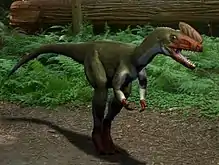
Below is a cladogram by Loewen et al. in 2013.[9]
| Tyrannosauroidea |
| |||||||||||||||||||||||||||||||||||||||||||||||||||||||||||||||||||||||||||||||||||||||||||||
See also
References
- Holtz, Thomas R. Jr. (2008) Dinosaurs: The Most Complete, Up-to-Date Encyclopedia for Dinosaur Lovers of All Ages Supplementary Information
- Palmer, D., ed. (1999). The Marshall Illustrated Encyclopedia of Dinosaurs and Prehistoric Animals. London: Marshall Editions. p. 114. ISBN 978-1-84028-152-1.
- Holtz, Thomas (December 1998). "A new phylogeny of the carnivorous dinosaurs" (PDF). Gaia. 15: 5–61.
- "Oldest T. rex relative identified". BBC News. 2009-11-04. Retrieved 2009-11-04.
- Woodward, A. S. (1910). "On a Skull of Megalosaurus from the Great Oolite of Minchinhampton (Gloucestershire)" (PDF). Quarterly Journal of the Geological Society. 66 (1–4): 111–115. doi:10.1144/GSL.JGS.1910.066.01-04.07.
- von Huene, F. (1932). "Die fossile Reptil-Ordnung Saurischia, ihre Entwicklung und Geschichte." Monographien zur Geologie und Palaeontologie (Serie 1), 4: 1–361.
- Paul, G.S. (1988). Predatory Dinosaurs of the World. New York: Simon and Schuster. pp. 366–369. ISBN 978-0-671-61946-6.
- Rauhut, Oliver W. M.; Milner, Angela C.; Moore-Fay, Scott (2010). "Cranial osteology and phylogenetic position of the theropod dinosaur Proceratosaurus bradleyi(Woodward, 1910) from the Middle Jurassic of England". Zoological Journal of the Linnean Society. 158: 155–195. doi:10.1111/j.1096-3642.2009.00591.x.
- Loewen, M.A.; Irmis, R.B.; Sertich, J.J.W.; Currie, P. J.; Sampson, S. D. (2013). Evans, David C (ed.). "Tyrant Dinosaur Evolution Tracks the Rise and Fall of Late Cretaceous Oceans". PLoS ONE. 8 (11): e79420. doi:10.1371/journal.pone.0079420. PMC 3819173. PMID 24223179.


